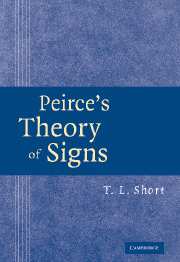Book contents
- Frontmatter
- Contents
- Preface
- Acknowledgments
- 1 Antecedents and Alternatives
- 2 The Development of Peirce's Semeiotic
- 3 Phaneroscopy
- 4 A Preface to Final Causation
- 5 Final Causation
- 6 Significance
- 7 Objects and Interpretants
- 8 A Taxonomy of Signs
- 9 More Taxa
- 10 How Symbols Grow
- 11 Semeiosis and the Mental
- 12 The Structure of Objectivity
- Bibliography
- Name Index
- Subject Index
12 - The Structure of Objectivity
Published online by Cambridge University Press: 28 July 2009
- Frontmatter
- Contents
- Preface
- Acknowledgments
- 1 Antecedents and Alternatives
- 2 The Development of Peirce's Semeiotic
- 3 Phaneroscopy
- 4 A Preface to Final Causation
- 5 Final Causation
- 6 Significance
- 7 Objects and Interpretants
- 8 A Taxonomy of Signs
- 9 More Taxa
- 10 How Symbols Grow
- 11 Semeiosis and the Mental
- 12 The Structure of Objectivity
- Bibliography
- Name Index
- Subject Index
Summary
The practice of knowing precedes its theory. It could not have been otherwise. How, for example, could we have known to rely on the evidence of our senses, before having already done so, with some success? Because practice precedes theory, theory has some evidence, of what works and what does not, to build on – even though what counts as ‘working’ or as ‘success’ is part of what is at issue. It is the thesis of this chapter that experience's precedence to principle never ceases, that there is no point after which methods cannot be modified by the results of their employment. More modestly, the thesis is that that was Peirce's view, in which he anticipated contemporary antifoundationalism. But he was in advance not only of his but of our contemporaries, as he knew how to avoid the subjectivism or relativism, the irrationalism and irrealism to which antifoundationalism is popularly supposed to lead. A further thesis of this chapter, then, is that objective inquiry is possible sans foundations and, indeed, in no other way.
Peirce did not speak of foundations in the present sense. He sometimes referred to his own work as laying foundations for further inquiry, but he did not mean an irrevisable foundation (chapter 3, section 1). The term ‘antifoundationalist’ not yet having come into vogue, he called himself a ‘fallibilist’, meaning that he regarded none of his beliefs as being immune to possible revision.
- Type
- Chapter
- Information
- Peirce's Theory of Signs , pp. 317 - 348Publisher: Cambridge University PressPrint publication year: 2007



